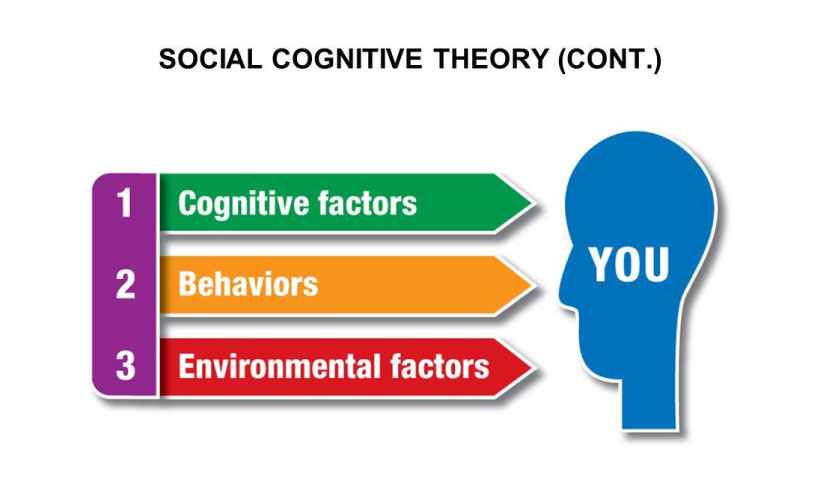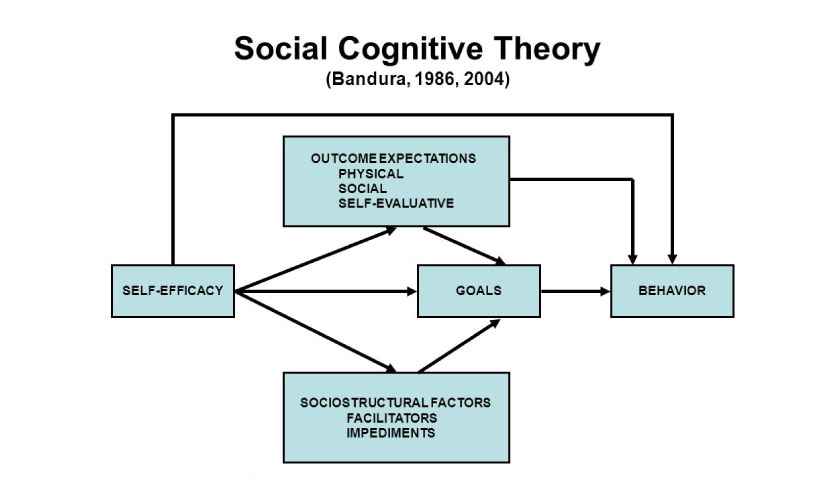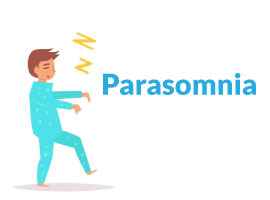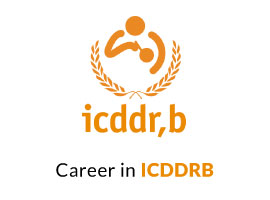Social cognitive theory is a theory of personality and behavior that emphasizes the role of observational learning, self-efficacy, and reciprocal determinism. It was developed by Albert Bandura in the 1960s and 1970s.
According to social cognitive theory, people learn new behaviors by observing the behavior of others and the consequences of that behavior. This process is called observational learning. For example, a child might learn to play the piano by watching their parents or a teacher play.

Self-efficacy is a person's belief in their ability to succeed at a task. People with high self-efficacy are more likely to attempt difficult tasks and persist in the face of challenges. People with low self-efficacy are more likely to give up easily.
Reciprocal determinism is the idea that people, their behavior, and their environment all influence each other. For example, a person's personality can influence their behavior, which can then influence their environment. In turn, their environment can then influence their personality.
Social cognitive theory has been used to explain a wide range of behaviors, including aggression, altruism, and learning. It has also been used to develop interventions to improve behavior, such as cognitive-behavioral therapy.
Here are some of the key concepts of social cognitive theory:
• Observational learning: People learn new behaviors by observing the behavior of others and the consequences of that behavior.
• Self-efficacy: A person's belief in their ability to succeed at a task.
• Reciprocal determinism: The idea that people, their behavior, and their environment all influence each other.
Social cognitive theory is a widely accepted theory of personality and behavior. It has been used to explain a wide range of behaviors and has also been used to develop interventions to improve behavior.
Social cognitive theory constructs
Social Cognitive Theory (SCT) is a theory of human behavior that emphasizes the role of cognitive, behavioral, and environmental factors in learning and behavior change. The theory has been widely used to explain a wide range of behaviors, including health behaviors, academic achievement, and social behavior.
The key constructs of SCT are:
• Reciprocal determinism:
This refers to the idea that behavior, personal factors, and the environment all influence each other in a dynamic and ongoing way. For example, a person's behavior can influence their environment (e.g., if they start exercising, they may make new friends who also exercise), which can then influence their behavior (e.g., they may be more likely to continue exercising).
• Observant learning:
This is the process of learning by watching others. When we observe others, we can learn new behaviors, attitudes, and beliefs. For example, if we see a friend lose weight by eating healthy and exercising, we may be more likely to adopt those behaviors ourselves.
• Self-efficacy:
This is a person's belief in their ability to successfully perform a behavior. Self-efficacy is thought to play a key role in behavior change. For example, if a person believes that they are not capable of quitting smoking, they are less likely to try to quit.
• Outcome expectations:
These are the beliefs about the consequences of a behavior. For example, a person may believe that if they quit smoking, they will improve their health. Outcome expectations can also influence behavior change. For example, if a person believes that quitting smoking will improve their health, they are more likely to try to quit.
• Motivation:
This is the driving force behind behavior. Motivation can be influenced by a variety of factors, including self-efficacy, outcome expectations, and personal goals.
The theory has been used to develop interventions to promote behavior change. For example, interventions to promote smoking cessation often focus on increasing self-efficacy and outcome expectations.
SCT is a powerful theory that can be used to understand and change behavior. The theory has been widely tested and has been found to be effective in a variety of settings.
Social cognitive theory in education
Social cognitive theory (SCT) is a learning theory that emphasizes the role of observational learning in the development of new behaviors. It has been widely used in education to explain how students learn new skills and knowledge.
SCT posits that learning occurs through a process of three steps:
1. Attention: The learner must pay attention to the model's behavior. This can be influenced by factors such as the model's attractiveness, competence, and similarity to the learner.
2. Retention: The learner must remember the model's behavior. This can be aided by factors such as verbal rehearsal, imagery, and feedback from others.
3. Reproduction: The learner must be able to reproduce the model's behavior. This can be facilitated by factors such as practice, feedback, and motivation.
In addition to these three steps, SCT also emphasizes the role of reinforcement and punishment in learning. Reinforcement is any event that increases the likelihood that a behavior will be repeated. Punishment is any event that decreases the likelihood that a behavior will be repeated.
SCT has been used to explain a wide range of learning in education, including the acquisition of academic skills, social skills, and self-regulation skills. It has also been used to explain why some students are more successful than others in school.
There are a number of ways that SCT can be applied in education. For example, teachers can use modeling to help students learn new skills. They can also use reinforcement and punishment to encourage students to engage in desired behaviors and discourage them from engaging in undesired behaviors.
SCT is a powerful learning theory that can be used to improve student learning in a variety of ways. However, it is important to note that SCT is not a complete explanation of learning. Other factors, such as genetics and motivation, also play a role in learning.
Here are some specific examples of how SCT can be applied in education:
• Teaching students how to solve math problems: A teacher can model how to solve a math problem, and then give students opportunities to practice solving problems on their own. The teacher can provide feedback and reinforcement to help students learn the correct procedures.
• Teaching students how to behave in class: A teacher can model appropriate classroom behavior, and then give students opportunities to practice behaving in a positive way. The teacher can provide feedback and reinforcement to help students learn the desired behaviors.
• Helping students develop self-regulation skills: A teacher can help students develop self-regulation skills by teaching them how to set goals, monitor their progress, and reward themselves for their accomplishments.
SCT is a valuable tool that can be used to improve student learning in a variety of ways. By understanding the basic principles of SCT, teachers can create learning environments that are more effective and engaging for their students.
Social cognitive theory vs social learning theory
Social cognitive theory (SCT) and social learning theory (SLT) are both theories of learning that emphasize the role of observation and imitation in learning new behaviors. However, there are some key differences between the two theories.
Social learning theory is based on the idea that people learn new behaviors by observing and imitating the behaviors of others. This process of observational learning can occur through direct observation, vicarious learning (watching others learn), or symbolic learning (reading about or hearing about others' learning).
Social cognitive theory is an extension of social learning theory. It takes into account the role of cognitive factors, such as attention, memory, and motivation, in the learning process. SCT also emphasizes the role of self-efficacy, which is a person's belief in their ability to successfully complete a task.
Key differences between social cognitive theory and social learning theory
• Scope: SCT has a broader theoretical scope than SLT. SCT includes a conceptualization of humans as agents capable of shaping their environment and of self-regulation. SLT, on the other hand, is limited to tackling the learning process in the social context.
• Role of cognitive factors: In SCT, cognitive factors play an important and equal role with environmental factors in the acquisition of new behavior and in its production. In SLT, the cognitive factors are only acknowledged to play a role in the acquisition of new behavior but not much or none at all in its production.
• Self-efficacy: SCT emphasizes the role of self-efficacy, which is a person's belief in their ability to successfully complete a task. SLT does not explicitly mention self-efficacy.
Applications of social cognitive theory and social learning theory
SCT and SLT have been applied to a wide range of topics, including:
• Education:
SCT has been used to develop educational programs that promote learning by observation and imitation. For example, SCT has been used to develop programs that teach children how to read and write, how to solve math problems, and how to behave in school.
• Health:
SCT has been used to develop programs that promote healthy behaviors, such as exercise, smoking cessation, and weight loss. For example, SCT has been used to develop programs that teach people how to exercise regularly, how to quit smoking, and how to lose weight.
• Criminal justice:
SCT has been used to develop programs that reduce crime and violence. For example, SCT has been used to develop programs that teach people how to resolve conflicts peacefully, how to manage anger, and how to make prosocial choices.
SCT and SLT are both important theories of learning. They provide a framework for understanding how people learn new behaviors through observation and imitation. SCT is a more comprehensive theory than SLT, as it takes into account the role of cognitive factors in the learning process. Both theories have been applied to a wide range of topics, including education, health, and criminal justice.
Social cognitive theory examples
Social cognitive theory is a theory of learning that emphasizes the role of observational learning in the development of new behaviors. Social cognitive theory has been used to explain a wide range of human behavior, including aggression, substance abuse, and mental health problems.
One of the most famous examples of observational learning is Bandura's Bobo doll experiment. In this experiment, Bandura showed children a film of an adult model hitting and kicking a Bobo doll. The children who saw the film were more likely to hit and kick the Bobo doll themselves than the children who did not see the film.
This experiment showed that children can learn new behaviors by observing others, even if they are not explicitly rewarded or punished for their behavior. In fact, Bandura found that children were more likely to imitate the aggressive behavior of the model if the model was rewarded for their behavior.
Social cognitive theory has been used to explain a wide range of human behavior, including:
• Aggression
• Substance abuse
• Mental health problems
• Learning
• Health behavior
• Prosocial behavior
The theory has also been used to develop interventions to change behavior. For example, social cognitive theory has been used to develop programs to reduce aggression, promote healthy eating, and encourage people to exercise.
Social cognitive theory is a powerful tool for understanding and changing human behavior. It is a theory that has been supported by a great deal of research, and it has been used to develop effective interventions to improve people's lives.
Here are some more examples of social cognitive theory in action:
• A child learns to ride a bike by watching their parents or older siblings.
• A student learns to solve a math problem by watching their teacher model the solution.
• A person learns to play a new video game by watching their friends play.
• A smoker quits smoking after seeing their friends and family members struggle with the addiction.
• A person with depression starts to feel better after seeing a therapist model coping skills.
Social cognitive theory can help us understand how people learn new behaviors, and it can also help us to change our own behavior in positive ways.









